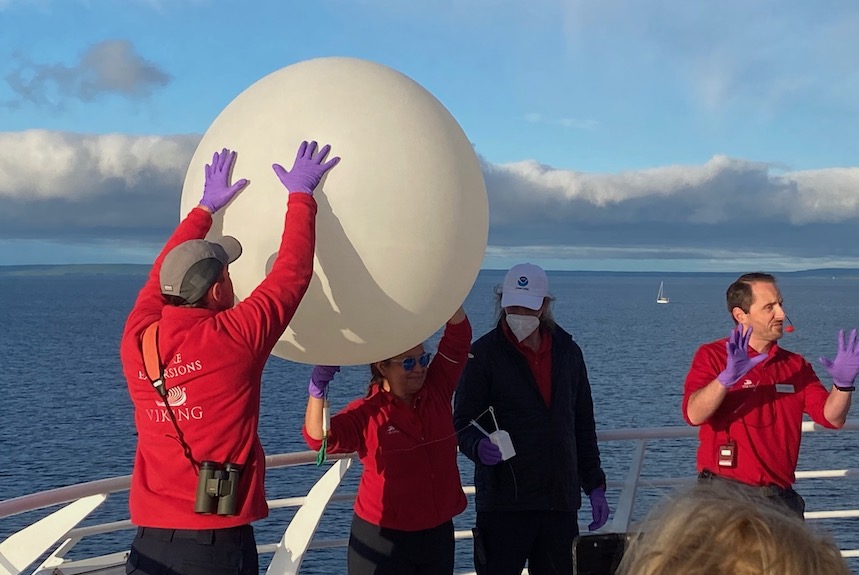
Viking scientists prepare to launch a weather balloon early one morning as passengers gathered to watch. Viking has a partnership with the U.S. National Oceanic and Atmospheric Administration. Photo by John Dowling
By John Dowling
A chilly breeze greeted passengers not long after dawn as they climbed to the uppermost deck of the cruise ship. They were warmed slightly by bright sunshine and steaming mugs of coffee passed around by the ship’s crew. But cold arising from the seemingly endless, expanse of water enveloped the ship; land was only faintly visible in the distance beneath a bank of clouds.
From the far end of the deck three figures emerged wearing bright red jackets. Holding aloft an enormous beige ball, they moved toward the gathering at midship in an awkward six-legged parade.
The ball was a helium-filled weather balloon, trailing an instrument package not much bigger than a smartphone. It was part of a simultaneous worldwide balloon launch by the U.S. National Oceanic and Atmospheric Administration to gather weather data up to the far reaches of the atmosphere, as high as 18 miles. After some explanation and a “10-9-8 …” countdown, the balloon was let loose to cheers, and soared toward the wispy cirrus clouds overhead. Everyone then headed down to the breakfast buffet, or back to sleep.
All in all, not your typical morning on a cruise ship, except for the buffet. But this ship was sailing far outside the normal routines of the global cruise industry.
The ship was the Viking Octantis, a newly launched, 660-foot, 380-passenger vessel built to be part cruise ship and part scientific research platform, that included a laboratory and its very own submarines.
With a jutting bow and heavily reinforced hull, the ship was designed to sail safely through Antarctic ice floes. But this August morning found the ship, not in the Antarctic, or any of the normal cruise destinations, but in Lake Huron, off the coast of Ontario province in the Great Lakes.
And the ship’s scientists – yes, this cruise ship has a small staff of scientists on Viking’s payroll – believe the Octantis (named for the pole star of the southern hemisphere) is pioneering a concept that could make cruise ships, often derided as floating environmental disasters, into a new tool for research into oceans, the atmosphere, the natural history of the Earth, pollution and the changing climate.
All are funded by passengers such as those who boarded the Octantis in the port of Milwaukee, where the sleek white ship looks as out of place as a new Maserati in a used car lot.
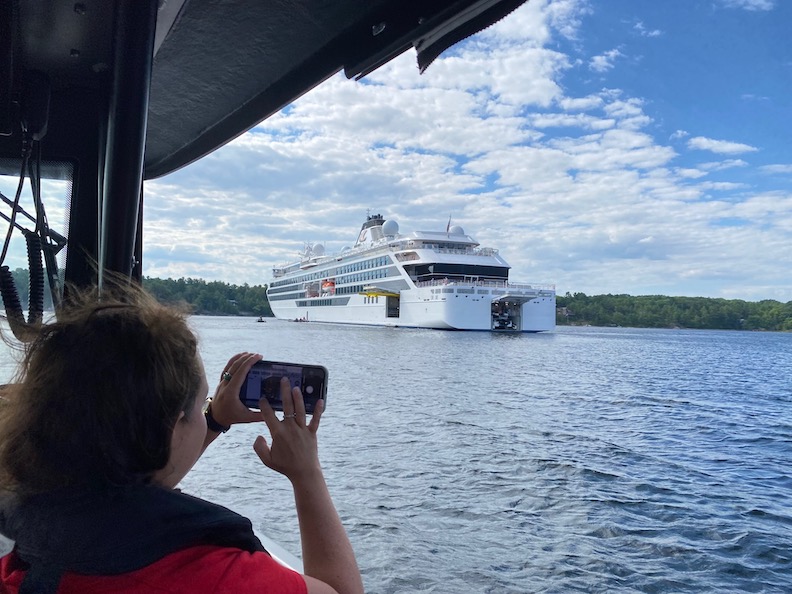
A passenger takes a photo of the Octantis with both hangar doors open. Special operations using smaller craft leave the ship via the rear opening while the yellow submarines exit on the side. Photo by John Dowling
“Expedition Ships” Boost the Cruise Business
Expedition cruises, featuring adventurous activities and exotic destinations, such as the Antarctic and the Galapagos Islands, have been an established niche in the cruise industry for decades. The Covid pandemic forced most cruise ships into port. Today the cruise industry has rebounded says Colleen McDaniel, editor-in-chief of CruiseCritic.com, led by expedition cruises designed “for those people who want a little more adventure.”
“They want to get out and do those long hikes, they want to get in a kayak, they want to get out in the rubber inflatable boats,” says McDaniel. “You talk to some of the people who do expedition cruising and they say they can’t imagine going on one of the larger cruises.”
Viking’s expedition ships were conceived by the company’s chairman, Torstein Hagen, a physicist by training. One of the first ships designed was completed in 2013, says Damon Stanwell-Smith, a marine scientist who is Viking’s head of science and sustainability and worked previously for the United Nations and the British Antarctic Survey.
The goal, he says, is to do “rigorous, real science that will be credible in academia,” and to allow guests – many who are academics or have scientific training — to participate. “Guests can be as involved as they want to be. We are finding there are many guests who can’t get enough science.”
Octantis sailed a northeast course from Milwaukee across Lake Michigan to Mackinac Island, one of the quintessential Midwest summer resorts for more than a century. Passengers sampled fudge on Main Street or rode horse-drawn carriages (the island bans cars) to lunch and drinks at the iconic white-columned Grand Hotel, which looms over the town and the harbor.
From there, though, the ship made a beeline for Canadian waters for a very practical reason. U.S. law sharply limits what ships without a U.S. crew and registration can do in its territorial waters. So, to deploy its array of water-borne devices, the Norwegian-flagged, international-crewed Octantis made its way to Georgian Bay, the northeast portion of Lake Huron.
From Kayaks to Submarines
A cavernous hangar at the stern of the ship contains a mini fleet of kayaks, Zodiac boats (think rubber dinghy on steroids with a powerful outboard motor) and a pair of speedy, 12-passenger “special operations boats” built on a design conceived for Norwegian special forces.
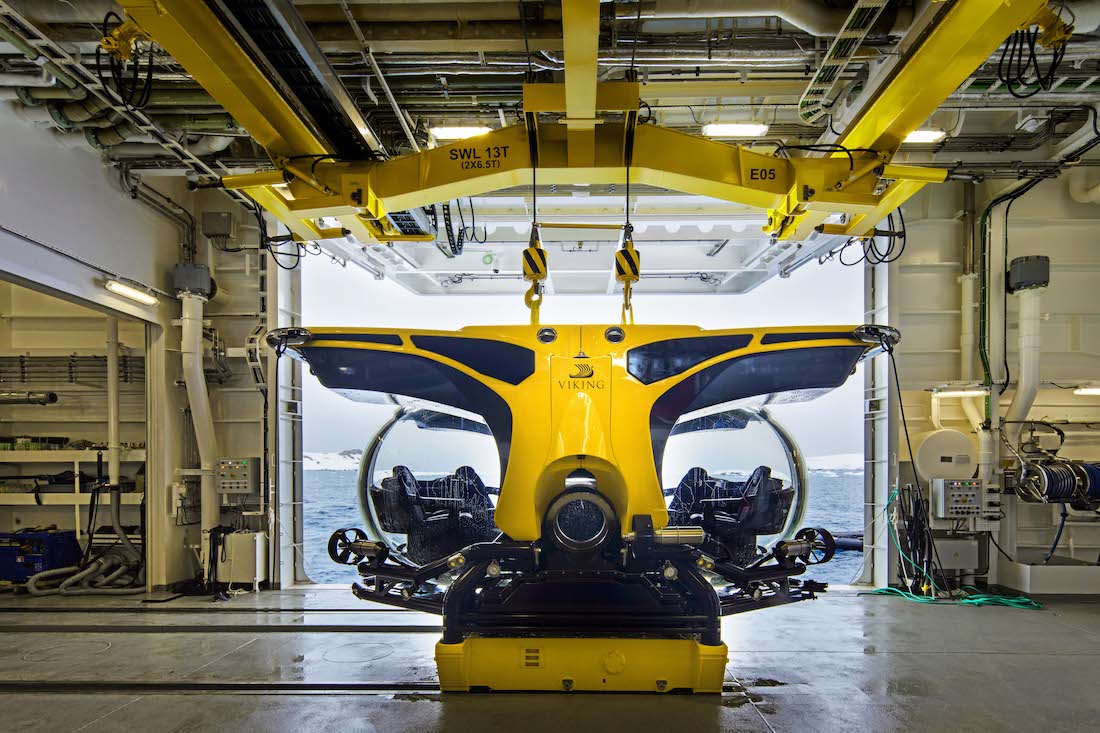
One of the yellow submarines aboard Viking’s Octantis, with its door open, in the Octantis hangar. The submarines are lifted out a side door for launch. Passengers are ferried via zodiac to the submarines to board. Photo courtesy of Viking
And then there are the submarines, two of them. Of course, they are yellow and are named John and Paul. Their sister craft, George and Ringo, reside aboard the Viking Polaris, which launched in the summer of 2022.
They look nothing like the submarines depicted in World War II movies. Instead of being cigar-shaped, they have a square deck on top and bulbous windows below, enabling passengers strapped into reclining chairs to observe the wonders of the deep. An array of cranes and ramps allows Octantis’ watercraft to be launched in a matter of minutes.
Overlooking the hangar is a 400-square-foot laboratory equipped for onboard analysis of marine and wildlife samples. One area of attention in the Great Lakes was the prevalence of microfibers that are shaken loose from the synthetic fabrics we wear and eventually find their way into the aquatic food chain. In place of a conventional depth finder, Octantis has a device with 256 discrete sonar beacons, enabling the mapping of lake and ocean floors.
Wisconsin’s state environmental agency has equipped Octantis with $75,000 worth of air sampling gear, enabling the agency to meet a legal mandate to monitor air quality. One current concern is ozone at low levels in the atmosphere. While ozone in the stratosphere absorbs harmful ultraviolet radiation, ozone close to Earth’s surface damages crops and endangers human health.
Scientists Partner with Sailors
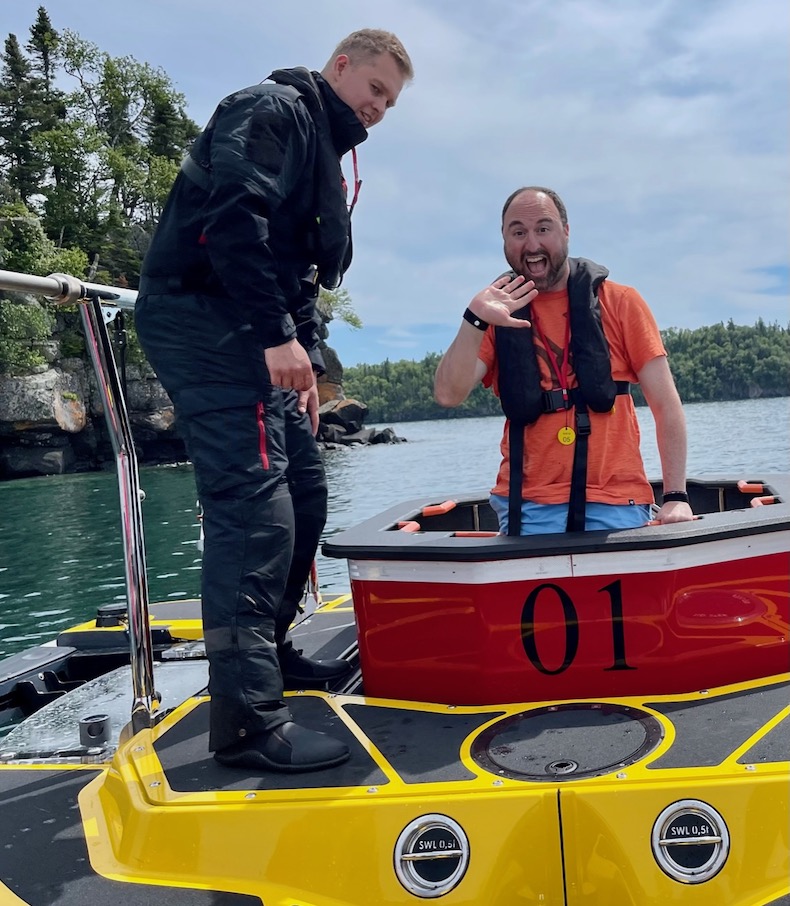
A pilot on one of the ship’s two yellow submarines waits for his passengers to board. Photo by Terri Colby
The diversity and sophistication of such equipment speak to the scientific potential of cruise ships like the Octantis, says Brandi Revels, a PhD geochemist from South Carolina who is one of Octantis’ scientific staff. One of the key gaps in environmental research, Revels explains, is water and atmospheric data from the middle of lakes, seas and oceans, because of the high cost of operating research vessels. But if even a few of the cruise ships operating around the world every day were equipped with gear to make measurements and take samples, the resulting data could open new doors of scientific understanding.
Revels and Octantis’ other scientists all emphasized another advantage of working with Viking: money. Researchers typically spend a huge chunk of their time applying for grants to fund their work. With funding commitments from Viking, that time can be devoted to science. Viking already has endowed a chair in polar marine science at Cambridge University and funds postdoctoral fellowships.
True to its emphasis on science, Octantis lacks many of the things one might expect on a cruise ship its size. There is no casino, no jewelry shop, no piano bar, only a duo playing classical and acoustic pop music in the afternoons and evenings. In place of a theater with floor shows there’s a roomy auditorium with a panoramic view from the ship’s stern and multiple video screens for scientific lectures and presentations on shipboard activities. There is a Nordic-themed spa and a couple of small hot-tub-style pools suited to the Antarctic as well as less extreme climates.
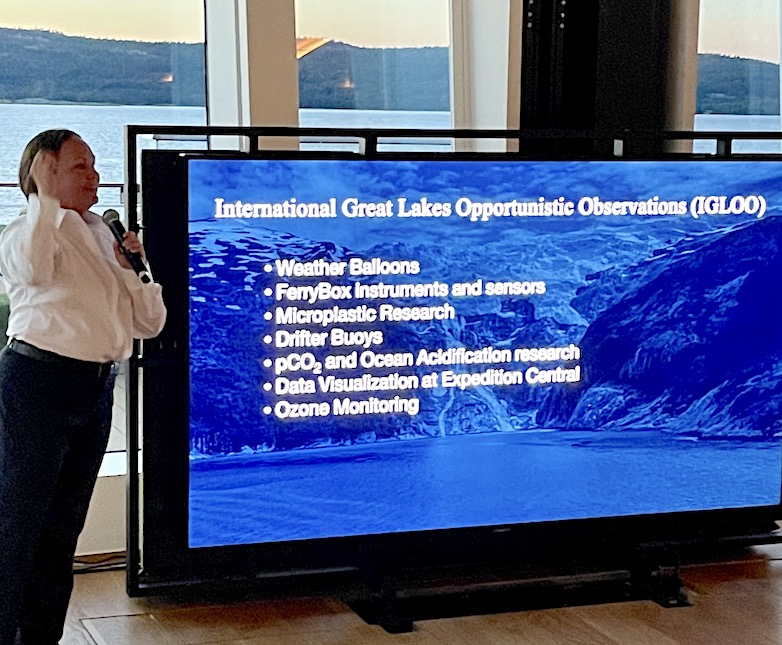
There are no evening stage shows aboard Viking’s Octantis, but lectures in the Aula auditorium, like this one by scientist Dr. Brandi Revels, are often standing-room-only affairs. Photo by Terri Colby
All the above resonated with Mary Cassoni, a community college professor from Carlsbad, Calif., who took the Octantis’ Great Lakes cruise with her husband, Rico, after seeing Viking’s advertising.
“It said it was the thinking person’s cruise,” Cassoni smiles. “And we consider ourselves thinking people. My undergraduate degree was in biology, so I’m a science person at heart! We liked that there was no cheesy entertainment at night, but instead, science lectures. We liked that there were resident scientists on board that you could have one-on-one conversations with, and we did that one night.
“We talked about climate change with people who study it every day,” she added. “And that felt good, like we were getting right to the source.” The couple also assisted scientists in sampling plankton, a microorganism that is the foundation of the aquatic food chain.
Visiting a Silver Mine, Birchbark Canoe and the Dessert Table
Even on a science cruise, the passengers need to eat. Among other things, Octantis offers a small sushi bar with a modest selection of nicely crafted maki and nigiri and a couple of varieties of sake. The grill turns out a small filet of beef cooked to a perfect medium rare, with a few spears of grilled asparagus topped with bearnaise sauce. Baked potatoes and Caesar salads are available along with sourdough bread and cabernet sauvignon. At lunch and dinner, no wine glass goes unfilled except by request, and the dessert table groans with enough cookies, cheesecake and ice cream to make a dietician wince.
Of course, almost every cruise makes stops so passengers can see interesting sites onshore. The Great Lakes do not offer castles, Gothic cathedrals, tropical beaches or any of the usual shore excursion fare, but the Octantis made stops that were fascinating in their own low-key way.
In the lakeside resort of Parry Sound, Ontario, we met a quartet of Ojibwe youth, members of a youth group who embarked on a remarkable project to reclaim a key piece of their culture that had been lost during European settlements. With the help of adult tribe members from Michigan their group built a canoe using centuries-old techniques and materials from the forest – cedar, ash and birch wood and bark, spruce roots to tie the birch hull to the frame, pitch from tree sap to seal the hull.
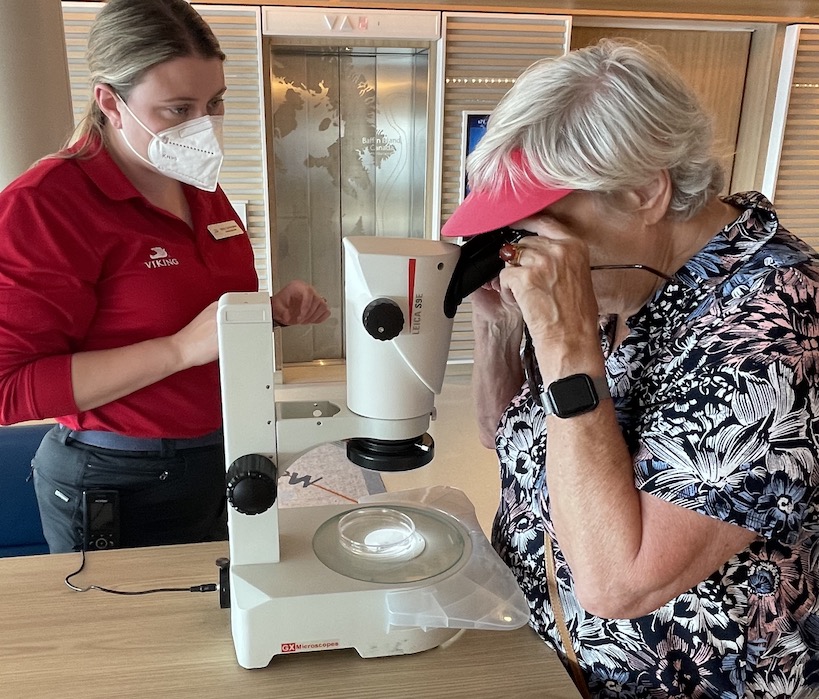
Aboard Octantis, passengers are invited to take a look at the scientists’ work, sometimes even helping to collect plankton from Lake Superior to examine it for microplastics. Photo by Terri Colby
And on the cruise’s last stop, a fifth-generation native led us through his tiny hamlet, Silver Islet, Ontario, which for a few years in the 19th century was the home of the world’s richest silver mine, and is now a string of rustic vacation cabins hugging the Lake Superior shore, many inhabited by descendants of the long-ago miners.
These places were nothing we’d read about in history books, nothing we’d heard of before boarding the ship. The places and presentations were plainspoken and bare bones, but totally authentic and wonderfully compelling, more so because it was living history, not the work of someone long dead.
Eight-day Great Lakes cruises aboard Octantis in the spring and summer of 2023 start at about $6,500 per person. The two ships have a full slate of summer Great Lakes cruises scheduled through August 2024, evidence of strong consumer demand.
Says Stanwell-Smith: “We feel we’re just spreading our wings.”![]()
John Dowling spent his career writing, editing and training journalists for a major global news organization. He lives in Chicago with his wife who is also a journalist.

